
Case Report
Austin J Forensic Sci Criminol. 2015;2(2): 1022.
Probable Identification from a Single Innominate Caught on a Fishing Hook
Midori Albert*
Department of Anthropology, University of North Carolina Wilmington, USA
*Corresponding author: Midori Albert, Department of Anthropology, University of North Carolina Wilmington, 601 S. College Road, Wilmington, NC 28403-5907, USA
Received: March 09, 2015; Accepted: April 15, 2015; Published: May 20, 2015
Abstract
This forensic anthropology case report involves an osteological examination of a single innominate bone caught by a fisherman while fishing on an ocean pier. The bone was skeletonized, odoriferous, with adherent barnacles; and it was determined to be from a young adult human male, about 24 or 25 to 29 years of age at the time of death. The main focus of the investigation was to ascertain whether or not the bone could have belonged to one of two missing individuals-one of whom was missing for five years (aged 18 years at the time of the missing persons report, but who could conceivably have been 23 years old if death occurred four months before the bone’s recovery) and the other who was witnessed to have drowned about four months prior to the discovery of the bone, and who was 25 years old at the time of death. This case is meaningful inasmuch as a significant amount of information could be gleaned from this one postcranial bone leading to a probable identification, whereas typically the best outcome for identification is derived from the recovery and analysis of nearly complete skeletal remains, especially if the skull/dentition is included. Presently, mtDNA results are pending; it is hopeful that the outcome will support a positive identification and closure to the case.
Keywords: Human innominate; Sex; Ancestry; Anomalies
Case Presentation
Detectives from the Carolina Beach, North Carolina, Police Department came to the Human Osteology and Forensic Anthropology Laboratory at the University of North Carolina Wilmington (UNCW) with a human innominate for osteological and forensic examination. The bone was discovered when a fisherman reeled it in from the ocean while fishing from Kure Beach Pier. The primary question was whether or not the bone could be determined to belong to either one of two individuals-a white male, aged 23 years (missing for five years, last seen at the beach, who was 18 years old at the time of the missing persons report; but, if deceased, he could have died anytime between ages 18 and 23 years), or a black male, aged 25 years who was witnessed to have drowned in a rip current in the ocean, roughly four months prior to discovery of the bone.
Evidence Condition and Time Since Death
The innominate (i.e., hip bone) was human and fully skeletonized, mostly dry, and highly malodorous. Since it is difficult to distinguish between decomposition odor and odor from a marine context [1] it is not known how long ago death occurred based solely on odor.
There was some minor erosion of bone, likely due to exposure to the marine environment (i.e., submersion and movement in salt water). Given that the erosion was minor, and because there was access to the water surface, and likely access to scavengers, as well as water movement, decomposition was probably accelerated. Based on these factors, a time since death estimation of less than a decade, and perhaps less than five years, is reasonable [1,2]. Further, there is evidence that complete skeletonization in a saltwater environment can be achieved in as few as 38 days postmortem [3].
There was evidence of encrustation; small barnacles had grown on the ilium and ischium (Figure 1). Barnacles are highly variable in terms of their growth and development, and lifespan. Once larvae attach to a firm substrate (e.g., bone), the overall time of development has been noted to occur in as few as 7 to 13 days; and some species of barnacles may live for up to 3 to 5 years [1].
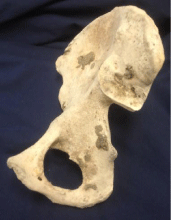
Figure 1a: Barnacles Right Innominate, Medial View Grayish-brown patches
are barnacles growing on the ilium.

Figure 1b: Barnacles Close-up of ilium.
The above evidence, therefore, suggests a time of death estimation between at least 45 days (at minimum, 38 days to skeletonization and 7 days for barnacle growth) and perhaps up to five years or more from the date of discovery of the bone. Moreover, numerous other variables, such as fluctuations in water temperature, effects of additional aquatic fauna, changes in water current, etc. could influence decomposition. As such, it is recognized that this postmortem interval is a broad estimation.
Skeletal Analysis
Sex
Features of the innominate were consistent with male. There was a narrow sciatic notch, narrow subpubic angle, relatively large acetabulum diameter, a rather narrow ischiopubic ramus, lack of a ventral arc, and a fairly large and ovoid obturator foramen; all of these characteristics were consistent with male [2,4] (Figure 2A,2B). The ischiopubic index (IPI) was 88, which according to Byers [2], based on data from Washburn [5], falls within the indeterminate range since ancestry is unknown (e.g., values below 84 are considered within the male range for individuals of unknown ancestry).
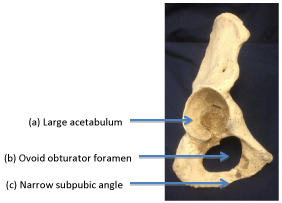
Figure 2a: Features consistent with Male Sex, Right Innominate, Lateral
View.

Figure 2b: Features consistent with Male Sex, Right Innominate, Medial
View.
It is noteworthy that in a test of the IPI method on a known-sex (male) sample, Drew [6] found that a greater number of individuals had an IPI that fell within the indeterminate range when compared to Washburn’s 1948 findings [5]. This method is potentially ambiguous due to issues related to accurately determining the landmarks used in measuring ischium length and pubis length. Drew [6] cautioned, “. . . the results cast doubt on using the IPI as a forensic sexing technique . . . (p. 590)”. Moreover, in a re-evaluation of Phenice’s [7] well known and widely used method of sex determination based on the ventral arc, subpubic contour, and medial aspect of the ischiopubic ramus, Kales et al. [8] found a mean correct sex classification of 94.5% for their sample, cross-validated for experienced observers, with low intraand inter-observer error. Tests on an independent validation sample yielded 86.2% accuracy in sex determination, leading the authors to conclude “this version of the Phenice technique is a reliable and valid method of sex estimation from the human innominate that meets the Daubert criteria for court admissibility (p. 104)” [8].
Findings from the above studies support the use of anthroposcopic observations in the determination of sex for this case of the unknown innominate particularly since it included the three key features of the ventral arc, subpubic contour, and ischiopubic ramus, and because the ischium-pubis index fell within the indeterminate range.
Ancestry
Ancestry could not be determined reliably from the innominate as various populations tend to show a high degree of overlap with regard to measures of the various dimension of this bone [9].
Age at death
The innominate belonged to a young adult. The iliac crest and ischial tuberosity epiphyses showed complete fusion, which generally occurs around ages 20 to 23 years [10]. Complete fusion of these epiphyses means that an individual was at least 20 to 23 years of age at the time of death.
The formation of the ventral rampart of the pubic symphysis appeared active at the time of death, which is consistent with an age range of 24 to 30 years. The presence of slight beveling and reduced ridges and furrows on the symphyseal face is consistent with an age range of 25 to 29 years [10]. In addition to the ventral beveling, the pubic symphysis was characterized by a superior ossific nodule; a sharp, yet not fully-defined rim along the dorsal border; and no clear delimitation of the superior and inferior extremity-features consistent with Suchey-Brooks Phase II, with a range of about 19 to 34 years of age, and a mean of 23.4 years of age [11] (Figure 3A).
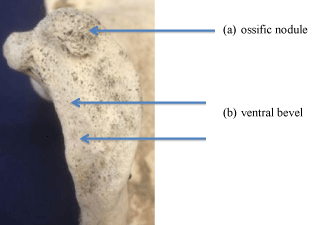
Figure 3a: Right Pubic Symphysis Consistent with Young Adult.
Features of the auricular surface included a relatively sharp, distinct apex (consistent with an age under 35 years). There was a lack of billowing and indistinct striae, which may have been due to erosion from the marine environment. However, this, along with the lack of activity in the retroauricular area, supported an age range of about 25 to 29 years (Figure 3B). This estimation derives from the original methodology developed by Lovejoy et al. [12] inasmuch as Mulhern and Jones [13] found it to be more accurate, when tested on their sample of American females and males, for individuals aged 20-49 years compared to the Buckberry and Chamberlain revised method [14] which was more accurate for individuals aged 50-69 years.
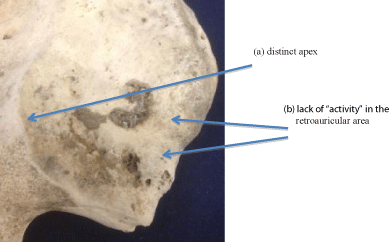
Figure 3b: Right Auricular Surface Consistent with Young Adult.
Based on the age information provided above, this innominate likely belonged to an individual who may have been at least 24 to 25 years of age and probably no older than roughly 29 years of age at the time of death.
Stature
Stature could not be determined from the innominate.
Anomalies or Indidividualizing traits
There was no evidence of any skeletal anomalies or individualizing traits.
Pathology-trauma and or Disease
There was no skeletal evidence on the innominate of any trauma or disease occurring antemortem or periomortem.
Postmortem damage
There was skeletal evidence of some damage occurring on the innominate consistent with mild erosion or “weathering” and animal scavenging. Small marks appeared on the anterio-superior portion of the ilium, medially, as well as just inferior to the anterior-inferior iliac spine; they averaged1-2 cm and may be associated with aquatic animal “gnawing” (Figure 4).
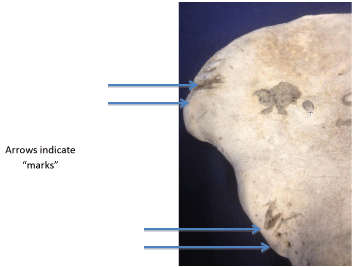
Figure 4: Right Ilium Showing Postmortem Damage Likely Associated with
Aquatic Animal Gnawing.
Conclusion
This was the right innominate of a young adult male, about 24 or 25 to 29 years of age at the time of death, which could have occurred at least 45 days and up to about five years or more prior to the time of discovery. A subsequent underwater search of the area where the innominate was recovered failed to turn up any further remains. The innominate was sent to a laboratory in Quantico, Virginia, for mtDNA analysis, where comparisons to both missing person’s family members are underway, to determine if a positive identification can be made.
At this time, the evidence supports a probable identification; the innominate is perhaps more consistent with the black male, aged 25 years at the time of his drowning rather than the white male, missing at the age of 18 years, five years prior to discovery of the bone, who could have been anywhere between 18 and 23 years of age at the time of death. While the findings do not rule out the possibility that the bone belonged to the white male who could have reached age 23 years, the pubic symphysis features-specifically, the active ventral rampart formation (which takes place around 24-30 years of age) and the presence of beveling (appearing around 25-29 years of age) seemed more consistent with the black male, aged 25 years at the time of death. This assessment was a verbal response to inquiry by law enforcement personnel asking for a professional opinion about which of the two individuals was more likely to be associated with the innominate. It is imperative to note that the innominate could have belonged to either of the two males, which was emphasized in the final written report.
This case represents the importance placed upon a single bone in forensic skeletal identification. Whereas the best-case scenarios for establishing identification are those for which nearly complete skeletal remains are recovered, this case is perhaps an exception in that of all single postcranial bones, the innominate is conceivably the ideal bone to have found since features of the innominate are some of the most accurate for estimating sex and age at death. The unusual circumstance of the fisherman reeling in the bone on his fishhook, and then being sure to report it and have it investigated and analyzed, was a serendipitous event that will hopefully and ultimately lead to closure for at least the one set of family members who are left wondering about the fate of their missing loved one.
References
- Sorg MH, Dearborn JH, Monahan E, Ryan HF, Sweeney KG, David E. “Forensic taphonomy in marine contexts.” In: Forensic Taphonomy: The Postmortem Fate of Human Remains. Haglund WD, Sorg MH, Editors. CRC Press. Boca Raton, FL. 1997; 567-604.
- Byers SN. Introduction to Forensic Anthropology, 4th edition. Pearson Education, Inc. Prentice Hall. Upper Saddle River NJ. 2011.
- Ayers LE. Differential Decomposition in Terrestrial, Freshwater, and Saltwater Environments: A Pilot Study. Theses and Dissertations-Anthropology. 2010.
- Buikstra JE, Komar DA. Forensic Anthropology: Contemporary Theory and Practice. Oxford University Press, NY. 2008.
- Washburn SL. Sex differences in the pubic bone. Am J Phys Anthropol. 1948; 6: 199-207.
- Drew R. Ancient movement patterns determine modern genetic variances in europe. Hum Biol. 2013; 85: 579-596.
- Phenice TW. A newly developed visual method of sexing the os pubis. Am J Phys Anthropol. 1969; 30: 297-301.
- Klales AR, Ousley SD, Vollner JM. A revised method of sexing the human innominate using Phenice's nonmetric traits and statistical methods. Am J Phys Anthropol. 2012; 149: 104-114.
- Patriquin ML, Steyn M, Loth SR. Metric assessment of race from the pelvis in South Africans. Forensic Sci Int. 2002; 127: 104-113.
- Scheurer L, Black S. The Juvenile Skeleton. Elsevier Academic Press, London, UK. 2004.
- Suchey JM, Brooks ST, Katz D. Instructional materials accompanying? female pubic symphyseal models of the Suchey-Brooks system. France Casting (Diane France, 2190 West Drake Road, Suite 259, Fort Collins, Colorado 80526), 1988.
- Lovejoy CO, Meindl RS, Pryzbeck TR, Mensforth RP. Chronological metamorphosis of the auricular surface of the ilium: a new method for the determination of adult skeletal age at death. Am J Phys Anthropol. 1985; 68: 15-28.
- Mulhern DM, Jones EB. Test of revised method of age estimation from the auricular surface of the ilium. Am J Phys Anthropol. 2005; 126: 61-65.
- Buckberry JL, Chamberlain AT. Age estimation from the auricular surface of the ilium: a revised method. Am J Phys Anthropol. 2002; 119: 231-239.